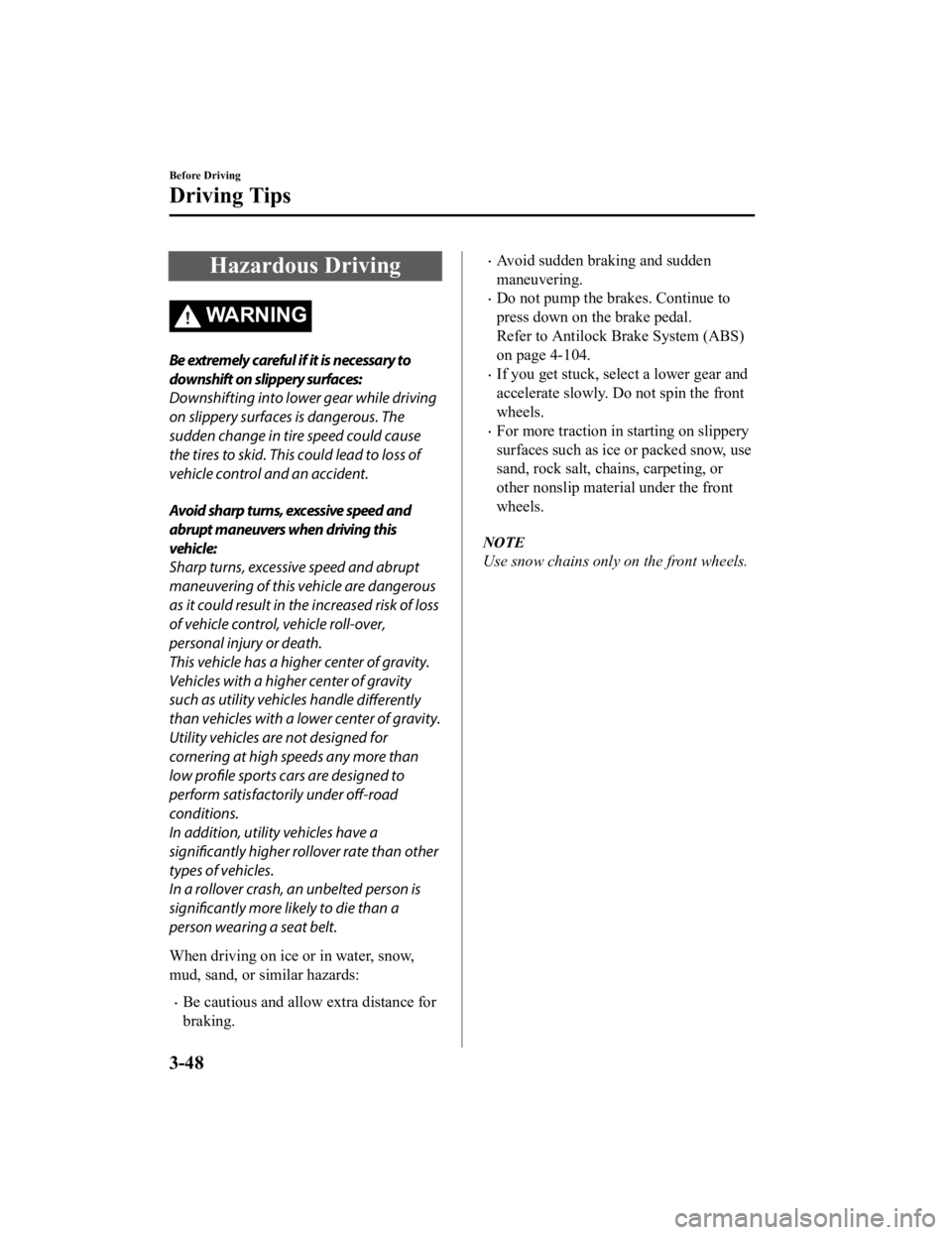lock MAZDA CX9 2023 Manual PDF
[x] Cancel search | Manufacturer: MAZDA, Model Year: 2023, Model line: CX9, Model: MAZDA CX9 2023Pages: 739, PDF Size: 11.69 MB
Page 147 of 739

5. After 20 seconds, the system is fullyarmed.
NOTE
’éĘThe theft-deterrent system can also be
armed by activating the auto relock
function with all the doors, the liftgate
and the hood closed.
Refer to Transmitter on page 3-5.
’éĘThe system will disarm if one of the
following operations takes place within
20 seconds after pressing the lock
button:
’éĘUnlocking any door.
’éĘOpening any door.
’éĘOpening the hood.
’éĘSwitching the ignition ON.
To rearm the system, do the arming
procedure again.
’éĘWhen the doors are locked by pressing
the lock button on the transmitter or
using the auxiliary key while the
theft-deterrent system is armed, the
hazard warning lights will flash once to
indicate that the system is armed.
Ō¢╝ To Turn Off an Armed System
An armed system can be turned off using
any one of the following methods:
’éĘPressing the unlock button on the
transmitter.
’éĘStarting the engine with the push button
start.
’éĘ(With the advanced keyless function)
’éĘPressing a request switch on the
doors.
The hazard warning lights will flash twice.
NOTE
When the doors are unlocked by pressing
the unlock button on the transmitter while
the theft-deterrent system is turned off, the
hazard warning lights will flash twice to
indicate that the system is turned off.
Ō¢╝ To Stop the Alarm
A triggered alarm can be turned off using
any one of the following methods:
’éĘPressing the unlock button on the
transmitter.
’éĘStarting the engine w
ith the push button
start.
’éĘ(With the advanced keyless function)
’éĘPressing a request switch on the
doors.
’éĘPressing the electric liftgate opener
while the key is being carried.
’éĘPressing the power liftgate button on
the transmitter.
The hazard warning ligh ts will flash twice.
Before Driving
Security System
3-46
CX-9_8LJ2-EA-22H_Edition1_old 2022-6-9 13:33:08
Page 149 of 739

Hazardous Driving
WA R N I N G
Be extremely careful if it is necessary to
downshift on slippery surfaces:
Downshifting into lower gear while driving
on slippery surfaces is dangerous. The
sudden change in tire speed could cause
the tires to skid. This could lead to loss of
vehicle control and an accident.
Avoid sharp turns, excessive speed and
abrupt maneuvers when driving this
vehicle:
Sharp turns, excessive speed and abrupt
maneuvering of this vehicle are dangerous
as it could result in the increased risk of loss
of vehicle control, vehicle roll-over,
personal injury or death.
This vehicle has a higher center of gravity.
Vehicles with a higher center of gravity
such as utility vehicles handle differently
than vehicles with a lower center of gravity.
Utility vehicles are not designed for
cornering at high speeds any more than
low profile sports cars are designed to
perform satisfactorily under off-road
conditions.
In addition, utility vehicles have a
significantly higher rollover rate than other
types of vehicles.
In a rollover crash, an unbelted person is
significantly more likely to die than a
person wearing a seat belt.
When driving on ice or in water, snow,
mud, sand, or similar hazards:
’éĘBe cautious and allow extra distance for
braking.
’éĘAvoid sudden braking and sudden
maneuvering.
’éĘDo not pump the brakes. Continue to
press down on the brake pedal.
Refer to Antilock Brake System (ABS)
on page 4-104.
’éĘIf you get stuck, sele ct a lower gear and
accelerate slowly. Do not spin the front
wheels.
’éĘFor more traction in starting on slippery
surfaces such as ice or packed snow, use
sand, rock salt, cha ins, carpeting, or
other nonslip material under the front
wheels.
NOTE
Use snow chains only on the front wheels.
Before Driving
Driving Tips
3-48
CX-9_8LJ2-EA-22H_Edition1_old 2022-6-9 13:33:08
Page 152 of 739

NOTE
The tire pressure monitoring system may
not function correctly when using tires
with steel wire reinforcement in the
sidewalls (page 4-257).
Ō¢╝ Tire Chains
Check local regulations before using tire
chains.
CAUTION
’āś
Chains may affect handling.
’āś Do not go faster than 50 km/h (30 mph)
or the chain manufacturer's
recommended limit, whichever is lower.
’āś Drive carefully and avoid bumps, holes,
and sharp turns.
’āś Avoid locked-wheel braking.
’āś Do not use chains on a temporary spare
tire; it may result in damage to the
vehicle and to the tire.
’āś Do not use chains on roads that are free
of snow or ice. The tires and chains could
be damaged.
’āś Chains may scratch or chip aluminum
wheels.
NOTE
’éĘThe tire pressure monitoring system may
not function correctly when using tire
chains.
’éĘUse of tire chains on a vehicle equipped
with P255/50R20 specification tires
could cause interference with the vehicle
body and scratching. If tire chains are to
be used, replace both front and rear tires
with P255/60R18 tires. Please consult
an Authorized Mazda Dealer.
Install the chains on the front tires only.
Do not use chains on the rear tires.
Please consult an Authorized Mazda
Dealer.
Installing the chains
1. Secure the chains on the front tires as
tightly as possible.
Always follow the chain
manufacturer's instructions.
2. Retighten the chains after driving 1/2ŌĆĢ1 km (1/4ŌĆĢ1/2 mile).
Before Driving
Driving Tips
3-51
CX-9_8LJ2-EA-22H_Edition1_old 2022-6-9 13:33:08
Page 162 of 739

To turn the trailer, place your hand at the bottom of the steering wheel and turn it in the
direction you want the trailer to go. Make only slight movements to prevent sharp or
prolonged turning.
Ascending a hill
Shift into a lower gear to reduce the possibility of overloadin g or overheating the engine, or
both.
Descending a hill
Shift into a lower gear and use engine compression as a braking effect.
WA R N I N G
Always use lower gears to reduce speed:
Holding the brake pedal down too long or too frequently is dangerous as it could cause the
brakes to overheat and lose power, resulting in loss of control and a serious accident. Use
lower gears to help reduce speed . Pull off the road and allow brakes to cool down whenever
braking performance feels reduced.
Overheated engine
The extra weight of the trailer may strain the engine on hot da ys and on long or steep
upgrades.
If the temperature gauge indicates overheating, turn off the ai r conditioner, drive safely to
the side of the road, park off t he right-of-way and wait for en gine to cool. Refer to
Overheating on page 7-23.
Parking
Always make sure the tires of the trailer and the tow vehicle a re blocked while parked.
Apply the parking brake firmly and put the transaxle in P.
Avoid parking on an incline, but if you must, follow these instructions:
1. Depress and hold down the brake pedal.
2. Have a helper put wheel blocks against the downhill side of a ll vehicle and trailer tires.
3. Then release the brake pedal slowly until the blocks bear the load.
’éĘIf the grade is downhill, turn the steering wheel so that the front of the front tires face
the curb.
’éĘIf it is uphill, face the rear of the front tires against the curb.
4. Firmly apply th e parking brake.
5. Shift the transaxle into P, and stop the engine.
Before Driving
To w i n g
3-61
CX-9_8LJ2-EA-22H_Edition1_old 2022-6-9 13:33:08
Page 163 of 739

To restart after parking on an incline:
1. With the transaxle in P, start the engine. (Be sure to depress and hold the brake pedal.)
2. Shift into gear.
3. Release the parking brake (also the foot brake) and pull away from the wheel blocks.
Stop; apply the parking brake and shift into P.
4. Have a helper retrieve the wheel blocks.
Fuel consumption
Trailer towing causes higher fuel consumption.
Maintenance
If you tow a trailer frequently, have your vehicle serviced as shown in Scheduled
Maintenance (page 6-4).
Before Driving
To w i n g
3-62
CX-9_8LJ2-EA-22H_Edition1_old 2022-6-9 13:33:08
Page 166 of 739

4When Driving
Information concerning safer driving and stopping.
Start/Stop Engine.............................. 4-4 Ignition Switch........ ..................... 4-4
Starting the Engine....................... 4-5
Turning the Engine Off...............4-10
Instrument Cluster and Display ............
........................................................... 4-11 Instrument Cluster and
Display........................................ 4-11
Instrument Cluster (Type A)....... 4-12
Instrument Cluster (Type B)....... 4-29
Instrument Cluster (Type C)....... 4-45
Active Driving Display
*............. 4-57
Automatic Transaxle....................... 4-59 Automatic Transaxle
Controls...................................... 4-59
Shift-Lock System...................... 4-60
Transaxle Ranges........................4-60
Manual Shift Mode..................... 4-62
Direct Mode
*.............................. 4-69
Driving Tips................................4-70
Switches and Controls..................... 4-71 Lighting Control......................... 4-71
Fog Lights
*................................. 4-77
Turn and Lane-Change
Signals........................................ 4-78
Windshield Wipers and
Washer........................................ 4-79
Rear Window Wiper and
Washer........................................ 4-82
Rear Window Defogg er.............. 4-83
Horn............................................ 4-84
Hazard Warning Flasher............. 4-85
HomeLink Wireless Control System
(Type A)
*.................................... 4-85
HomeLink Wireless Control System
(Type B)
*.................................... 4-89
Brake................................................ 4-94 Brake System.............................. 4-94
AUTOHOLD.............................. 4-98
Hill Launch Assist (HLA)........ 4-102
ABS/TCS/DSC/Trailer Stability
Control (TSC)/Off-Road Traction
Assist............................................... 4-104 Antilock Brake System
(ABS)........................................4-104
Traction Control System
(TCS)........................................ 4-105
Dynamic Stability Control
(DSC)........................................4-107
Trailer Stability Control
(TSC)........................................ 4-108
Off-Road Traction Assist
*........ 4-109
Drive Selection............................... 4-111 Drive Selection......................... 4-111
i-ACTIV AWD............................... 4-113 i-ACTIV AWD Operation
*....... 4-113
Power Steering............................... 4-115 Power Steering..........................4-115
*Some models.4-1
CX-9_8LJ2-EA-22H_Edition1_old 2022-6-9 13:33:08
Page 169 of 739

Ignition Switch
Ō¢╝Push Button Start Positions
The system operates only when the key is
within operational range.
Each time the push button start is pressed,
the ignition switches
in the order of off,
ACC, and ON. Pressing the push button
start again from ON switches the ignition
off.
Indicator light
NOTE
’éĘThe engine starts by pressing the push
button start while depressing the brake
pedal. To switch the ignition position,
press the push button start without
depressing the pedal.
’éĘDo not leave the ignition switched ON
while the engine is not running. Doing
so could result in the battery going
dead. If the selector lever is in the P
position, and the ignition is in ACC, the
ignition switches off automatically after
about 25 minutes.
Off
The power supply to electrical devices
turns off and the push button start
indicator light (amber) also turns off.
WA R N I N G
Before leaving the driver's seat, always
switch the ignition off, set the parking
brake, and make sure the selector lever is in
P position:
Leaving the driver's seat without switching
the ignition off, setting the parking brake,
and shifting the selector lever to P position
is dangerous. Unexpected vehicle
movement could occur which could result
in an accident.
In addition, if your intention is to leave the
vehicle for even a short period, it is
important to switch the ignition off, as
leaving it in another position will disable
some of the vehicle's security systems and
run the battery down.
ACC (Accessory)
Some electrical accessories will operate
and the indicator light (amber) illuminates.
NOTE
The keyless entry system does not function
while the push button start has been
pressed to ACC, and the doors will not
lock/unlock even if they have been locked
manually.
ON
This is the normal running position after
the engine is started. The indicator light
(amber) turns off. (The indicator light
(amber) illuminates when the ignition is
switched ON and the engine is not
running.)
Some indicator lights/warning lights
should be inspected before the engine is
started (page 4-11).
When Driving
Start/Stop Engine
4-4
CX-9_8LJ2-EA-22H_Edition1_old 2022-6-9 13:33:08
Page 224 of 739

Automatic Transaxle Controls
Lock-release button
Indicates the selector lever can be shifted freely into any position.
Indicates that you must hold in the lock-release button to shift.
Indicates that you must depress the brake pedal and hold in the lock-release
button to shift (The ignition must be switched ON).
Various Lockouts:
NOTE
The Sport AT has an option that is not included in the traditional automatic transaxle that
gives the driver the option of selecting each ge ar instead of leaving it to the transaxle to
shift gears. Even if you intend to use the automatic transaxle functions as a traditional
automatic, you should also be aware that you can inadvertently shift into manual shift mode
and an inappropriate gear may be retained as the vehicle speed increases. If you notice the
engine speed going higher or hear the engine racing, confirm you have not accidentally
slipped into manual shift mode (page 4-62).
When Driving
Automatic Transaxle
4-59
CX-9_8LJ2-EA-22H_Edition1_old 2022-6-9 13:33:08
Page 225 of 739

Shift-Lock System
The shift-lock system prevents shifting out
of P unless the brake pedal is depressed.
To shift from P:
1. Depress and hold the brake pedal.
2. Start the engine.
3. Press and hold the lock-release button.
4. Move the selector lever.
NOTE
’éĘWhen the ignition is switched to ACC or
the ignition is switched off, the selector
lever cannot be shifted from P position.
’éĘThe ignition cannot be switched to OFF
if the selector lever is not in P position.
Ō¢╝ Shift-Lock Override
If the selector lever will not move from P
using the proper shift procedure, continue
to hold down the brake pedal.
1. Remove the shift-lock override cover
using a cloth-wrapped flat head
screwdriver.
2. Insert a screwdriver and push it down.
Cover
3. Press and hold the lock-release button.
4. Move the selector lever.
Take the vehicle to an Authorized Mazda
Dealer to have the system checked.
Transaxle Ranges
’éĘThe shift position indication in the
instrument cluster illuminates.
Refer to Indication/Indicator Lights on
page 4-25, 4-41.
’éĘThe selector lever must be in P or N
position to operate the starter.
P (Park)
P locks the transaxle and prevents the
front wheels from rotating.
WA R N I N G
Always set the selector lever to P position
and set the parking brake:
Only setting the selector lever to the P
position without using the parking brake to
hold the vehicle is dangerous. If P fails to
hold, the vehicle could move and cause an
accident.
CAUTION
’āś Shifting into P, N or R while the vehicle is
moving can damage your transaxle.
’āś Shifting into a driving gear or reverse
when the engine is running faster than
idle can damage the transaxle.
R (Reverse)
In position R, the vehicle moves only
backward. You must be at a complete stop
before shifting to or from R, except under
rare circumstances as explained in
Rocking the Vehicle (page 3-49).
NOTE
(With parking sensor system)
When Driving
Automatic Transaxle
4-60
CX-9_8LJ2-EA-22H_Edition1_old 2022-6-9 13:33:08
Page 226 of 739

When the selector lever is shifted to the R
position with the ignition switched ON, the
parking sensor system is activated and a
beep sound is heard.
Refer to Parking Sensor System on page
4-276.
N (Neutral)
In N, the wheels and transaxle are not
locked. The vehicle will roll freely even
on the slightest inclin e unless the parking
brake or brakes are on.
WA R N I N G
If the engine is running faster than idle, do
not shift from N or P into a driving gear:
It's dangerous to shift from N or P into a
driving gear when the engine is running
faster than idle. If this is done, the vehicle
could move suddenly, causing an accident
or serious injury.
Do not shift into N when driving the
vehicle:
Shifting into N while driving is dangerous.
Engine braking cannot be applied when
decelerating which could lead to an
accident or serious injury.
CAUTION
Do not shift into N when driving the
vehicle. Doing so can cause transaxle
damage.
NOTE
Apply the parking brake or depress the
brake pedal before moving the selector
lever from N position to prevent the
vehicle from moving unexpectedly.
D (Drive)
D is the normal driving position. From a
stop, the transaxle will automatically shift
through a 6-gear sequence.
M (Manual)
M is the manual shift mode position.
Gears can be shifted up or down by
operating the selector lever. Refer to
Manual Shift Mode on page 4-62.
Ō¢╝ Shift Position Indication
Instrument Cluster (Type A)
Instrument Cluster (Type B/C)
The selector position is indicated when the
ignition is switched ON.
Gear position indication
In manual shift mode, the ŌĆ£MŌĆØ of the shift
position indication illuminates and the
numeral for the selected gear is displayed.
When Driving
Automatic Transaxle
4-61
CX-9_8LJ2-EA-22H_Edition1_old
2022-6-9 13:33:08